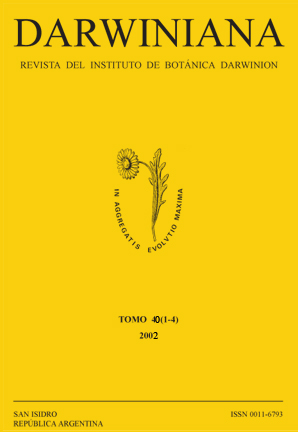Morphology of the inflorescence in Verbenaceae-Verbenoideae III. * Tribe Lantaneae p.p.
DOI:
https://doi.org/10.14522/darwiniana.2014.401-4.235Keywords:
Verbenaceae, Lantaneae, InflorescenceAbstract
In this contribution, the tribe Lantaneae is considered in a broad sense. The morphology and typology of inflorescences in Lantana, Neosparton, Xeroaloysia, Acantholippia, Aloysia, Phyla, Bouchea, Chascanum, Stachytarpheta, Lampaya and Diostea are analyzed; Lippia has been treated in a previous paper. Inflorescences in Lantaneae belong to the polytelic type. Florescences are, in most species, spikes or sometimes spike-like racemes, varying in arrangement, spacing and number of flowers. Floral bracteoles are only present in Bouchea and Chascanum Sect. Chascanum. The most frequent pattern of the compound inflorescence is a homothetic (di) pleiobotryum with specialized long and short paracladia. This pattern, characteristic of Lantana, Phyla and Xeroaloysia, is also present in most species of Aloysia and one species of Acantholippia. Two Aloysia species have a paniculiform heterothetic pleiobotryum. Bouchea, Chascanum and Stachytarpheta have similar inflorescence. Most of their species inflorescences are dichasially ramified heterothetic pleiobotrya. Neosparton, Lampaya, Diostea and Acantholippia generally have monobotrya, which it could be interpreted as a result of reductive tendency related to the xeromorfic syndrome of these genera. The results of this study are compared with several taxonomic systems proposed for the Tribe Lantaneae.Downloads
Published
31-12-2002
How to Cite
Múlgura de Romero, M. E., Martínez, S. G., Atkins, S., & Rotman, A. D. (2002). Morphology of the inflorescence in Verbenaceae-Verbenoideae III. * Tribe Lantaneae p.p. Darwiniana, Nueva Serie, 40(1-4), 1–15. https://doi.org/10.14522/darwiniana.2014.401-4.235
Issue
Section
Anatomy and Morphology
License

Starting on 2012, Darwiniana Nueva Serie uses Licencia Creative Commons Atribución-NoComercial 2.5 Argentina .






